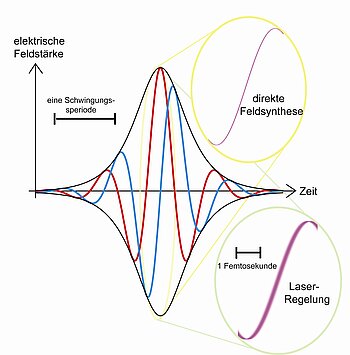Optical methods allow real-time investigations on the shortest time scales, which are not accessible by other methods. With lasers, light pulses of 100 attoseconds can be generated today (1 attosecond = 10-18s = one billionth of a billionth of a second). Scientists at the Max Born Institute for Nonlinear Optics and Short Pulse Spectroscopy (MBI) in Berlin have now set a record for the shortest man-controllable time of 12 attoseconds. They report about it in Nature Photonics.
Light is a very high frequency electromagnetic wave. For visible light, a single oscillation of the oscillating electric field takes only about 1200-2500 attoseconds. In ultrashort light pulses, the light performs only a few oscillations. In order to achieve the maximum possible field strength, the center of the pulse must coincide with a maximum of the field, which corresponds to the phase position shown in Fig. (Red line). Pulses from conventional short-pulse lasers show large fluctuations in the position of the field maxima relative to the pulse center and do not reach the maximum field strength in a stable manner. Therefore, methods have been developed in recent years, with which the position of the field maxima, that is, the phase of the light oscillation, can be stabilized.
